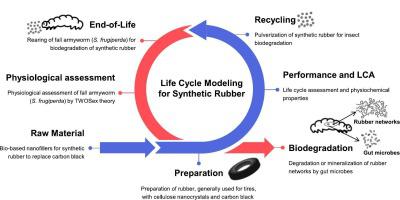当前位置:
X-MOL 学术
›
Sustain. Mater. Technol.
›
论文详情
Our official English website, www.x-mol.net, welcomes your feedback! (Note: you will need to create a separate account there.)
Cellulose nanocrystal filled synthetic rubber: Sustainable production, environmental assessment and end-of-life biodegradation by polyphagous pests
Sustainable Materials and Technologies ( IF 9.6 ) Pub Date : 2024-04-21 , DOI: 10.1016/j.susmat.2024.e00947 Sohail Yasin , Muhammad Hafeez , Munir Hussain , Awais Mahmood , Song Yihu , Zheng Qiang , Shabbir H. Gheewala , Xiaowei Li , Yang Li , Jianfeng Shi , Chaohua Gu
Sustainable Materials and Technologies ( IF 9.6 ) Pub Date : 2024-04-21 , DOI: 10.1016/j.susmat.2024.e00947 Sohail Yasin , Muhammad Hafeez , Munir Hussain , Awais Mahmood , Song Yihu , Zheng Qiang , Shabbir H. Gheewala , Xiaowei Li , Yang Li , Jianfeng Shi , Chaohua Gu

|
Plastic and rubber productions have reached staggering levels, leading to environmental concerns and accumulation of microplastics (MPs) rising in ecosystems. Rubber tires, a major source of MPs, pose further challenges due to excessive use of carbon black (CB) nanofillers in their manufacturing process, stresses on adding the element of sustainability to these products. This study emphasizes on the production of bio-based cellulose nanocrystals (CNC) filled synthetic rubber with sustainability assessment through life cycle assessment (LCA). It investigates the end-of-life (EOL) biodegradation potentials of rubber waste using a polyphagous pest, fall armyworm (FAW) (). The results revealed that the production of CNC filled rubber demonstrate enhanced modulus compared to CB nanofillers, while requires substantial resource consumption, impacting abiotic resource depletion–fossil fuels (ADPf), freshwater ecotoxicity (CTUe), global warming potential (GWP), particulate matter (PM) and other impact categories. Emissions associated with CNC filled rubber during EOL phase are comparatively lower than CB, rendering CNC based rubbers a potentially viable choice from an environmental sustainability perspective. EOL pest biodegradation of CNC filled rubber showed negligible to no discernible physiological effects, potentially attributed to the presence of a diverse gut microbiota community in FAW (). These findings highlight the relationship between physiochemical properties and CNC biodegradability in synthetic rubbers, aiding the development of sustainable EOL strategies for rubber waste management.
中文翻译:

纤维素纳米晶体填充合成橡胶:可持续生产、环境评估和多食性害虫的报废生物降解
塑料和橡胶产量已达到惊人水平,导致环境问题和生态系统中微塑料 (MP) 的积累不断增加。橡胶轮胎是 MP 的主要来源,由于在制造过程中过度使用炭黑 (CB) 纳米填料,带来了进一步的挑战,强调在这些产品中添加可持续性元素。本研究重点关注生物基纤维素纳米晶体 (CNC) 填充合成橡胶的生产,并通过生命周期评估 (LCA) 进行可持续性评估。它使用一种多食性害虫秋粘虫 (FAW) 来研究橡胶废料的寿命终止 (EOL) 生物降解潜力 ()。结果表明,与炭黑纳米填料相比,数控填充橡胶的生产模量有所提高,但需要大量资源消耗,影响非生物资源消耗——化石燃料 (ADPf)、淡水生态毒性 (CTUe)、全球变暖潜势 (GWP)、颗粒物(PM) 和其他影响类别。在 EOL 阶段与 CNC 填充橡胶相关的排放量相对低于 CB,因此从环境可持续性的角度来看,CNC 橡胶是一个潜在可行的选择。 CNC 填充橡胶的 EOL 害虫生物降解显示出可以忽略不计甚至没有明显的生理效应,这可能归因于秋粘虫中存在多样化的肠道微生物群落 ()。这些发现强调了合成橡胶的理化特性与 CNC 生物降解性之间的关系,有助于制定橡胶废物管理的可持续 EOL 策略。
更新日期:2024-04-21
中文翻译:

纤维素纳米晶体填充合成橡胶:可持续生产、环境评估和多食性害虫的报废生物降解
塑料和橡胶产量已达到惊人水平,导致环境问题和生态系统中微塑料 (MP) 的积累不断增加。橡胶轮胎是 MP 的主要来源,由于在制造过程中过度使用炭黑 (CB) 纳米填料,带来了进一步的挑战,强调在这些产品中添加可持续性元素。本研究重点关注生物基纤维素纳米晶体 (CNC) 填充合成橡胶的生产,并通过生命周期评估 (LCA) 进行可持续性评估。它使用一种多食性害虫秋粘虫 (FAW) 来研究橡胶废料的寿命终止 (EOL) 生物降解潜力 ()。结果表明,与炭黑纳米填料相比,数控填充橡胶的生产模量有所提高,但需要大量资源消耗,影响非生物资源消耗——化石燃料 (ADPf)、淡水生态毒性 (CTUe)、全球变暖潜势 (GWP)、颗粒物(PM) 和其他影响类别。在 EOL 阶段与 CNC 填充橡胶相关的排放量相对低于 CB,因此从环境可持续性的角度来看,CNC 橡胶是一个潜在可行的选择。 CNC 填充橡胶的 EOL 害虫生物降解显示出可以忽略不计甚至没有明显的生理效应,这可能归因于秋粘虫中存在多样化的肠道微生物群落 ()。这些发现强调了合成橡胶的理化特性与 CNC 生物降解性之间的关系,有助于制定橡胶废物管理的可持续 EOL 策略。

































 京公网安备 11010802027423号
京公网安备 11010802027423号